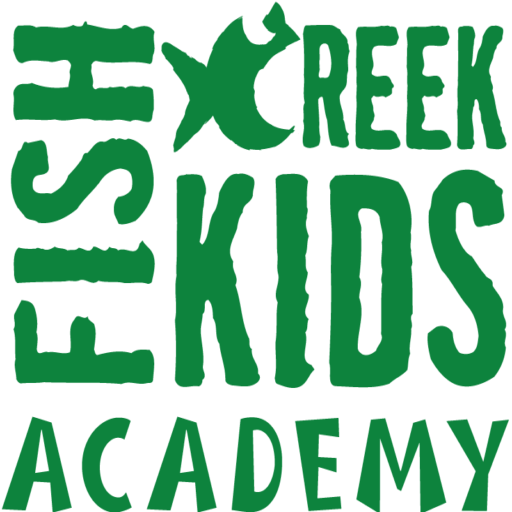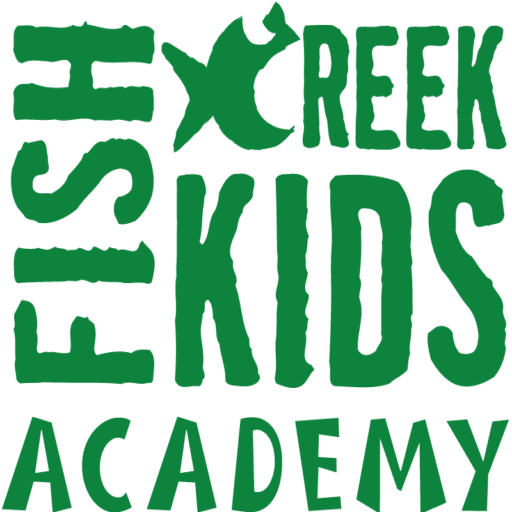At first glance, statistics on parent engagement in schools look promising. In a 2007 survey tracking parental involvement, 89 percent of respondents indicated that they had attended a PTO or other school meeting in the past year. Similarly, 78 percent attended a parent-teacher conference, 65 percent did fundraising for their kids’ school and 46 percent volunteered on a committee at the school.
While these numbers make it clear that the majority of parents are engaged, they also demonstrate that the benefits of parental involvement in early childhood education have not yet compelled 100 percent of parents to become involved. Furthermore, while the survey cited above reflected positive changes and growth in parental involvement, numbers declined between 2007 and 2012, according to the U.S. Department of Education, National Center for Education Statistics.
In other words, while many parents understand the importance of parent involvement in early childhood, there is still a significant number that struggles to engage, regardless of their desire to do so.
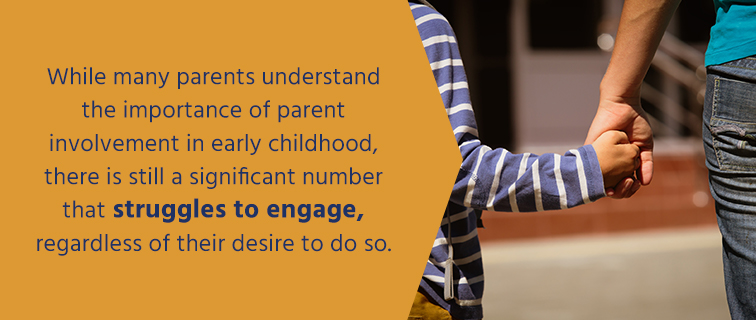 As an institution committed to early childhood education, we are equally committed to promoting how parents can help their children learn. We understand that providing for a family economically can often conflict with attending parent-teacher conferences or PTO meetings. For households with either a single parent or two working parents, sometimes families must make tough choices about how they allot their time.
With that in mind, this guide is designed to explain how parents can be involved in a child’s learning, regardless of their work schedule. If you are eager to support your young learner, but you worry you can’t because of your work commitments, this guide will give you the tools to do both without becoming overstressed.
As an institution committed to early childhood education, we are equally committed to promoting how parents can help their children learn. We understand that providing for a family economically can often conflict with attending parent-teacher conferences or PTO meetings. For households with either a single parent or two working parents, sometimes families must make tough choices about how they allot their time.
With that in mind, this guide is designed to explain how parents can be involved in a child’s learning, regardless of their work schedule. If you are eager to support your young learner, but you worry you can’t because of your work commitments, this guide will give you the tools to do both without becoming overstressed.
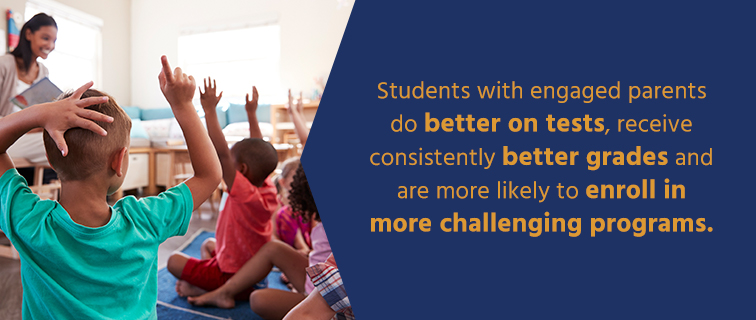 Studies have also demonstrated school success is contingent on attendance, and students with engaged parents miss less school.
However, beyond academic performance, the children of parents who are involved also display better social skills, are more adaptive to new situations and have fewer behavior issues.
If there are issues with behavior or academic performance, involved parents are also quicker to address the problem. Present parents can intervene sooner, and they become aware of any issues more immediately. Plus, more active collaboration between teachers, administrators and parents will allow all involved to address small issues that might go unnoticed on their own, but over time, could become more serious.
Additionally, when compared to other initiatives designed to increase student performance or improve student health, parent engagement efforts are more effective. For example, when it comes to youth health initiatives, such as anti-tobacco education, such efforts did not improve youth health to levels equal to that of parental engagement. While school programs should continue educating children about the dangers of tobacco use or the harm caused by bullying, effective parent engagement initiatives make the goals of other programs more achievable.
Further, parent engagement initiatives are easier to aim at a wide range of age groups, meaning these initiatives can function as interventions for younger kids for whom other student health initiatives would be inappropriate.
Studies have also demonstrated school success is contingent on attendance, and students with engaged parents miss less school.
However, beyond academic performance, the children of parents who are involved also display better social skills, are more adaptive to new situations and have fewer behavior issues.
If there are issues with behavior or academic performance, involved parents are also quicker to address the problem. Present parents can intervene sooner, and they become aware of any issues more immediately. Plus, more active collaboration between teachers, administrators and parents will allow all involved to address small issues that might go unnoticed on their own, but over time, could become more serious.
Additionally, when compared to other initiatives designed to increase student performance or improve student health, parent engagement efforts are more effective. For example, when it comes to youth health initiatives, such as anti-tobacco education, such efforts did not improve youth health to levels equal to that of parental engagement. While school programs should continue educating children about the dangers of tobacco use or the harm caused by bullying, effective parent engagement initiatives make the goals of other programs more achievable.
Further, parent engagement initiatives are easier to aim at a wide range of age groups, meaning these initiatives can function as interventions for younger kids for whom other student health initiatives would be inappropriate.
 In other words, a helicopter parent doesn’t give a child the opportunity to come up with solutions on their own, while an unengaged parent can leave a child feeling unsafe in the same situations. Any program of parent engagement must reflect the balance between being overprotective and being overly detached.
Parental engagement also isn’t a single event, but instead a pattern of support that extends across the entirety of a child’s educational experience. Ideally, parental engagement should begin as soon as a child’s formal educational experience starts. By the time a student enters preschool, a parent should begin exploring strategies of how to be effectively involved.
In other words, a helicopter parent doesn’t give a child the opportunity to come up with solutions on their own, while an unengaged parent can leave a child feeling unsafe in the same situations. Any program of parent engagement must reflect the balance between being overprotective and being overly detached.
Parental engagement also isn’t a single event, but instead a pattern of support that extends across the entirety of a child’s educational experience. Ideally, parental engagement should begin as soon as a child’s formal educational experience starts. By the time a student enters preschool, a parent should begin exploring strategies of how to be effectively involved.
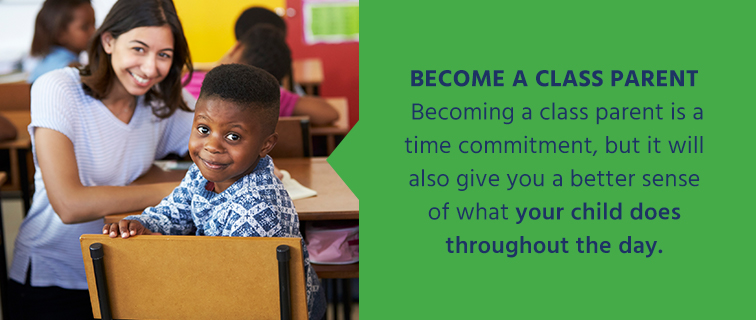 Class parenting does not require you to work in your child’s class specifically. In fact, if you are concerned about being overprotective, volunteering elsewhere in the school is an excellent way to get involved, while also giving your child space. Your presence in the school will be reassuring, but they also won’t feel the constant need to act differently because their mom or dad is in the room. Even volunteering in the front office can have a profound impact.
Not only will class parenting support your child, but it will also give you a better sense of what your child does throughout the day. It will help you make more home/school connections, finding ways to bring the curriculum into your home so your child’s educational experience doesn’t end when they leave school.
Class parenting does not require you to work in your child’s class specifically. In fact, if you are concerned about being overprotective, volunteering elsewhere in the school is an excellent way to get involved, while also giving your child space. Your presence in the school will be reassuring, but they also won’t feel the constant need to act differently because their mom or dad is in the room. Even volunteering in the front office can have a profound impact.
Not only will class parenting support your child, but it will also give you a better sense of what your child does throughout the day. It will help you make more home/school connections, finding ways to bring the curriculum into your home so your child’s educational experience doesn’t end when they leave school.
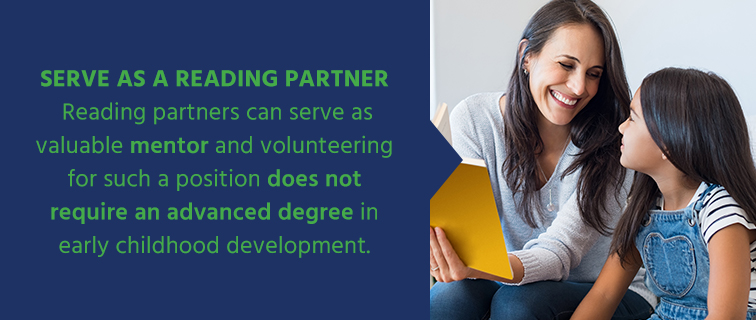 Reading partners can also serve as valuable mentors. For those who might be behind in literacy, reading aloud or attempting to read can be frustrating and embarrassing. By partnering with an adult, students can feel safer as they struggle, which is crucial, because student reading will not improve without sustained practice.
Like a classroom parent position, it is best to serve as a reading partner with a student who is not your child. That way, you’ll be able to interact with some of your child’s peers and remain visible without being overbearing. This is a position best suited for someone who can make consistent time in their weekly schedule, as children will often come to depend on their reading partner, and sporadic engagement can be hard on the student.
Reading partners can also serve as valuable mentors. For those who might be behind in literacy, reading aloud or attempting to read can be frustrating and embarrassing. By partnering with an adult, students can feel safer as they struggle, which is crucial, because student reading will not improve without sustained practice.
Like a classroom parent position, it is best to serve as a reading partner with a student who is not your child. That way, you’ll be able to interact with some of your child’s peers and remain visible without being overbearing. This is a position best suited for someone who can make consistent time in their weekly schedule, as children will often come to depend on their reading partner, and sporadic engagement can be hard on the student.
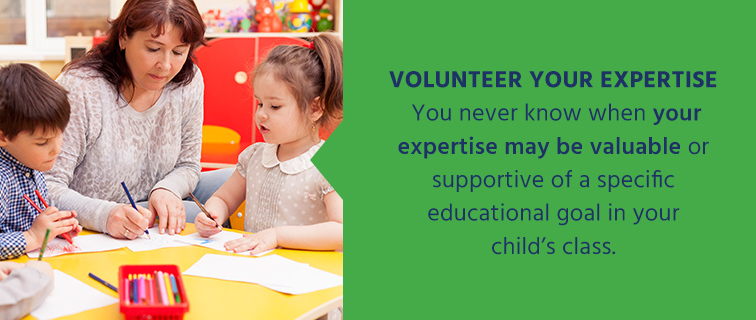
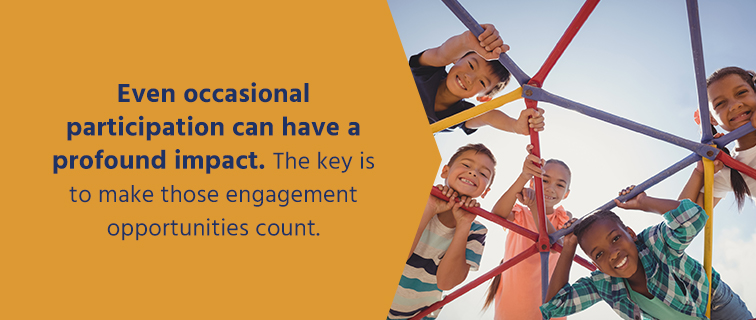 The key is to make those engagement opportunities count. If you can only do one or two things a year, make sure your kid is engaged in those moments, as well. If your kid comes home upset because one of their classmates has a parent there every week, find ways to connect in the time that you do have. Spend time at home supporting your child’s classroom endeavors so when they’re at school, they don’t see their peer’s parent as more involved — just differently involved.
But most importantly, don’t feel guilty. Volunteering beyond what is reasonable or feeling shame while doing so makes that engagement less effective. It’s far better to do a few things over the course of the year enthusiastically than to overwhelm yourself by committing to do more than you can handle. Your child may end up interpreting that stress as a resentment.
The key is to make those engagement opportunities count. If you can only do one or two things a year, make sure your kid is engaged in those moments, as well. If your kid comes home upset because one of their classmates has a parent there every week, find ways to connect in the time that you do have. Spend time at home supporting your child’s classroom endeavors so when they’re at school, they don’t see their peer’s parent as more involved — just differently involved.
But most importantly, don’t feel guilty. Volunteering beyond what is reasonable or feeling shame while doing so makes that engagement less effective. It’s far better to do a few things over the course of the year enthusiastically than to overwhelm yourself by committing to do more than you can handle. Your child may end up interpreting that stress as a resentment.
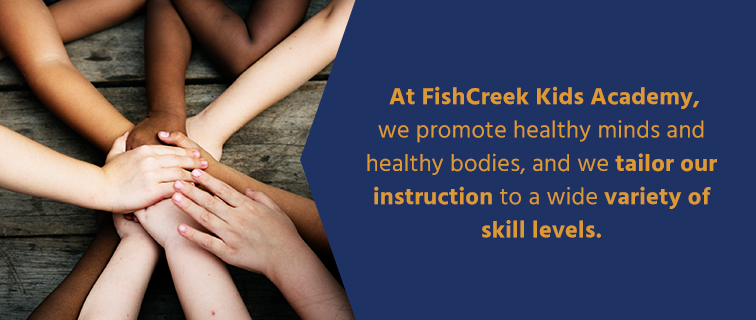 We work with children as young as six weeks and as old as 12 years. We promote healthy minds and healthy bodies, and we tailor our instruction to a wide variety of skill levels. Our level of personal attention pairs perfectly with parental engagement.
If you are ready to explore how your child will excel at FishCreek Kids Academy, contact us today or register for our availability waitlist.
We work with children as young as six weeks and as old as 12 years. We promote healthy minds and healthy bodies, and we tailor our instruction to a wide variety of skill levels. Our level of personal attention pairs perfectly with parental engagement.
If you are ready to explore how your child will excel at FishCreek Kids Academy, contact us today or register for our availability waitlist.
 As an institution committed to early childhood education, we are equally committed to promoting how parents can help their children learn. We understand that providing for a family economically can often conflict with attending parent-teacher conferences or PTO meetings. For households with either a single parent or two working parents, sometimes families must make tough choices about how they allot their time.
With that in mind, this guide is designed to explain how parents can be involved in a child’s learning, regardless of their work schedule. If you are eager to support your young learner, but you worry you can’t because of your work commitments, this guide will give you the tools to do both without becoming overstressed.
As an institution committed to early childhood education, we are equally committed to promoting how parents can help their children learn. We understand that providing for a family economically can often conflict with attending parent-teacher conferences or PTO meetings. For households with either a single parent or two working parents, sometimes families must make tough choices about how they allot their time.
With that in mind, this guide is designed to explain how parents can be involved in a child’s learning, regardless of their work schedule. If you are eager to support your young learner, but you worry you can’t because of your work commitments, this guide will give you the tools to do both without becoming overstressed.
Why Is Parent Engagement in Education Important?
According to repeated studies, parent engagement correlates with improved student performance both academically and socially. Furthermore, these studies demonstrate different racial or socio-economic backgrounds are not as influential as the level of parental engagement. First and foremost, students with engaged parents do better on tests, receive consistently better grades and are more likely to enroll in more challenging programs. Not only do they do well in school, but they are also proactive about challenging themselves. Studies have also demonstrated school success is contingent on attendance, and students with engaged parents miss less school.
However, beyond academic performance, the children of parents who are involved also display better social skills, are more adaptive to new situations and have fewer behavior issues.
If there are issues with behavior or academic performance, involved parents are also quicker to address the problem. Present parents can intervene sooner, and they become aware of any issues more immediately. Plus, more active collaboration between teachers, administrators and parents will allow all involved to address small issues that might go unnoticed on their own, but over time, could become more serious.
Additionally, when compared to other initiatives designed to increase student performance or improve student health, parent engagement efforts are more effective. For example, when it comes to youth health initiatives, such as anti-tobacco education, such efforts did not improve youth health to levels equal to that of parental engagement. While school programs should continue educating children about the dangers of tobacco use or the harm caused by bullying, effective parent engagement initiatives make the goals of other programs more achievable.
Further, parent engagement initiatives are easier to aim at a wide range of age groups, meaning these initiatives can function as interventions for younger kids for whom other student health initiatives would be inappropriate.
Studies have also demonstrated school success is contingent on attendance, and students with engaged parents miss less school.
However, beyond academic performance, the children of parents who are involved also display better social skills, are more adaptive to new situations and have fewer behavior issues.
If there are issues with behavior or academic performance, involved parents are also quicker to address the problem. Present parents can intervene sooner, and they become aware of any issues more immediately. Plus, more active collaboration between teachers, administrators and parents will allow all involved to address small issues that might go unnoticed on their own, but over time, could become more serious.
Additionally, when compared to other initiatives designed to increase student performance or improve student health, parent engagement efforts are more effective. For example, when it comes to youth health initiatives, such as anti-tobacco education, such efforts did not improve youth health to levels equal to that of parental engagement. While school programs should continue educating children about the dangers of tobacco use or the harm caused by bullying, effective parent engagement initiatives make the goals of other programs more achievable.
Further, parent engagement initiatives are easier to aim at a wide range of age groups, meaning these initiatives can function as interventions for younger kids for whom other student health initiatives would be inappropriate.
What Exactly Is Parent Engagement in Education?
It’s easy to define parent engagement. According to the Centers of Disease Control and Prevention (CDC), “Parent engagement in schools is defined as parents and school staff working together to support and improve the learning, development and health of children and adolescents.” But what does this collaboration look like? Perhaps it would be best to start with what parent engagement is not. We’ve recently seen the rise of the term “helicopter parent” — someone who intervenes so quickly and so often their child never has a chance to learn from their mistakes. Unfortunately, children who grow up with helicopter parents lack the space to grow, and often become resentful of their parents. It is important to remember a child is their own person. They need to have the space to explore their personality and uncover their desires and dreams. But they are not adults, so they still need a safety net. There will always be times a child will need to feel a parent’s support, as that support will give them the confidence to take risks and try out new ideas. In other words, a helicopter parent doesn’t give a child the opportunity to come up with solutions on their own, while an unengaged parent can leave a child feeling unsafe in the same situations. Any program of parent engagement must reflect the balance between being overprotective and being overly detached.
Parental engagement also isn’t a single event, but instead a pattern of support that extends across the entirety of a child’s educational experience. Ideally, parental engagement should begin as soon as a child’s formal educational experience starts. By the time a student enters preschool, a parent should begin exploring strategies of how to be effectively involved.
In other words, a helicopter parent doesn’t give a child the opportunity to come up with solutions on their own, while an unengaged parent can leave a child feeling unsafe in the same situations. Any program of parent engagement must reflect the balance between being overprotective and being overly detached.
Parental engagement also isn’t a single event, but instead a pattern of support that extends across the entirety of a child’s educational experience. Ideally, parental engagement should begin as soon as a child’s formal educational experience starts. By the time a student enters preschool, a parent should begin exploring strategies of how to be effectively involved.
Top 13 Strategies for Improving Parental Involvement
With that in mind, let’s explore some effective strategies for encouraging parental involvement. These strategies reflect a wide variety of time commitments, meaning both parents with flexible availability and those with a demanding work schedule can find a strategy that works best for them:-
Become a Class Parent
 Class parenting does not require you to work in your child’s class specifically. In fact, if you are concerned about being overprotective, volunteering elsewhere in the school is an excellent way to get involved, while also giving your child space. Your presence in the school will be reassuring, but they also won’t feel the constant need to act differently because their mom or dad is in the room. Even volunteering in the front office can have a profound impact.
Not only will class parenting support your child, but it will also give you a better sense of what your child does throughout the day. It will help you make more home/school connections, finding ways to bring the curriculum into your home so your child’s educational experience doesn’t end when they leave school.
Class parenting does not require you to work in your child’s class specifically. In fact, if you are concerned about being overprotective, volunteering elsewhere in the school is an excellent way to get involved, while also giving your child space. Your presence in the school will be reassuring, but they also won’t feel the constant need to act differently because their mom or dad is in the room. Even volunteering in the front office can have a profound impact.
Not only will class parenting support your child, but it will also give you a better sense of what your child does throughout the day. It will help you make more home/school connections, finding ways to bring the curriculum into your home so your child’s educational experience doesn’t end when they leave school.
-
Assist With Extracurricular Activities
-
Serve as a Reading Partner
 Reading partners can also serve as valuable mentors. For those who might be behind in literacy, reading aloud or attempting to read can be frustrating and embarrassing. By partnering with an adult, students can feel safer as they struggle, which is crucial, because student reading will not improve without sustained practice.
Like a classroom parent position, it is best to serve as a reading partner with a student who is not your child. That way, you’ll be able to interact with some of your child’s peers and remain visible without being overbearing. This is a position best suited for someone who can make consistent time in their weekly schedule, as children will often come to depend on their reading partner, and sporadic engagement can be hard on the student.
Reading partners can also serve as valuable mentors. For those who might be behind in literacy, reading aloud or attempting to read can be frustrating and embarrassing. By partnering with an adult, students can feel safer as they struggle, which is crucial, because student reading will not improve without sustained practice.
Like a classroom parent position, it is best to serve as a reading partner with a student who is not your child. That way, you’ll be able to interact with some of your child’s peers and remain visible without being overbearing. This is a position best suited for someone who can make consistent time in their weekly schedule, as children will often come to depend on their reading partner, and sporadic engagement can be hard on the student.
-
Donate Gently Used or New Toys to Your Child’s Classroom or School
- Craft supplies
- Wooden blocks
- LEGO®
- Costume items that can be used for dress up
- Puzzles and board games
- Activities that develop fine motor skills such as lacing cards
- Puppets
- Markers, crayons and other drawing supplies
-
Volunteer for a Special Project

-
Spread the Word About Your Child’s School With an Online Review
-
Make Playdough or Other Homemade Items for the Class
- 2 Tbs coconut or vegetable oil
- 2 cups lukewarm water
- 2 cups flour
- ¾ cup salt
- 4 tsp cream of tartar
-
Drop in and Read Your Child’s Favorite Book to the Class
-
Attend Open Houses
-
Volunteer Your Expertise
-
Fundraise
-
Lend Other Talents
-
Be Creative
Working Parent Involvement in Education
Working parents with packed schedules are often stressed by the thought of choosing between providing economically or being supportive of their child’s education. Hopefully, even the busiest parent can find a way to implement one or two of the above strategies. But it’s important to emphasize even occasional participation can have a profound impact. The parent who is in a child’s school every week is not automatically a better parent than someone who can only participate once or twice a year. The key is to make those engagement opportunities count. If you can only do one or two things a year, make sure your kid is engaged in those moments, as well. If your kid comes home upset because one of their classmates has a parent there every week, find ways to connect in the time that you do have. Spend time at home supporting your child’s classroom endeavors so when they’re at school, they don’t see their peer’s parent as more involved — just differently involved.
But most importantly, don’t feel guilty. Volunteering beyond what is reasonable or feeling shame while doing so makes that engagement less effective. It’s far better to do a few things over the course of the year enthusiastically than to overwhelm yourself by committing to do more than you can handle. Your child may end up interpreting that stress as a resentment.
The key is to make those engagement opportunities count. If you can only do one or two things a year, make sure your kid is engaged in those moments, as well. If your kid comes home upset because one of their classmates has a parent there every week, find ways to connect in the time that you do have. Spend time at home supporting your child’s classroom endeavors so when they’re at school, they don’t see their peer’s parent as more involved — just differently involved.
But most importantly, don’t feel guilty. Volunteering beyond what is reasonable or feeling shame while doing so makes that engagement less effective. It’s far better to do a few things over the course of the year enthusiastically than to overwhelm yourself by committing to do more than you can handle. Your child may end up interpreting that stress as a resentment.
Partner With a School That Understands You
The best way to balance a busy schedule with volunteering opportunities is to partner with a school that understands what you’re going through. Here at FishCreek Kids Academy, we pride ourselves in our small classroom size as well as our flexible parental engagement. Serving Magnolia, Texas, as well as Woodforest, the Woodlands, Conroe and Montgomery, we take early childhood learning seriously. While some childcare facilities are happy with simply keeping kids busy, we know this is an opportunity to give young children a leg up academically, emotionally and socially. We work with children as young as six weeks and as old as 12 years. We promote healthy minds and healthy bodies, and we tailor our instruction to a wide variety of skill levels. Our level of personal attention pairs perfectly with parental engagement.
If you are ready to explore how your child will excel at FishCreek Kids Academy, contact us today or register for our availability waitlist.
We work with children as young as six weeks and as old as 12 years. We promote healthy minds and healthy bodies, and we tailor our instruction to a wide variety of skill levels. Our level of personal attention pairs perfectly with parental engagement.
If you are ready to explore how your child will excel at FishCreek Kids Academy, contact us today or register for our availability waitlist. 